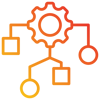 Algorithms
Algorithms
AI algorithms are computer programs that enable machines to perform tasks that typically require human intelligence
AI algorithms are vital components of artificial intelligence systems that enable machines to learn from data and perform tasks autonomously
By understanding different types of AI algorithms and how they function, we can better appreciate their impact across various fields and their potential to transform industries.
What are AI Algorithms?
AI algorithms are sets of instructions that allow machines to analyze data, learn from it, and make decisions. They serve as the backbone of AI systems, enabling computers to perform complex tasks autonomously, such as recognizing patterns, understanding language, and solving problems.

 Types of AI Algorithms
Types of AI Algorithms
AI algorithms can be categorized based on their functionality and learning approaches. Here are some key types:
Supervised Learning Algorithms
These algorithms learn from labeled data, where the input data is associated with the correct output. Common examples include:
- Linear Regression: Used for predicting continuous values.
- Decision Trees: Used for classification and regression tasks.
- Neural Networks: Used for various applications including image and speech recognition.
Unsupervised Learning Algorithms
These algorithms work with unlabeled data to find patterns or groupings within the data. Examples include:
- K-means Clustering: Groups data into clusters based on similarity.
- Principal Component Analysis (PCA): Reduces dimensionality while preserving variance in data.
Reinforcement Learning Algorithms
In this approach, an agent learns by interacting with its environment and receiving feedback in the form of rewards or penalties. This type is commonly used in robotics and game playing.
Search and Optimization Algorithms
These algorithms help in exploring vast search spaces to find optimal solutions. Examples include:
- A* Search Algorithm: Used for pathfinding and graph traversal.
- Genetic Algorithms: Mimic natural selection to optimize solutions.
Natural Language Processing (NLP) Algorithms
These algorithms enable machines to understand and generate human language. Examples include:
- Sentiment Analysis: Determines the emotional tone behind a series of words.
- Named Entity Recognition (NER): Identifies proper nouns in text.
These algorithms enable machines to interpret and understand visual information from the world. Examples include Convolutional Neural Networks (CNNs), which are specialized for processing grid-like data such as images.
 How AI Algorithms Work
How AI Algorithms Work
AI algorithms operate by processing large amounts of data to identify patterns and make predictions or decisions based on that data. The process typically involves:
- Data Collection: Gathering relevant data for training the algorithm.
- Training: Feeding the data into the algorithm so it can learn from it. This involves adjusting parameters to minimize errors in predictions.
- Validation: Testing the algorithm on new data to evaluate its performance.
- Deployment: Implementing the trained model in real-world applications where it can make predictions or decisions.

 Applications of AI Algorithms
Applications of AI Algorithms
AI algorithms have a wide range of applications across various industries, including:
- Healthcare: Assisting in diagnosis, drug discovery, and personalized medicine by analyzing medical data.
- Finance: Fraud detection through pattern recognition in transaction data.
- Marketing: Personalizing customer experiences through recommendation systems based on user behavior.
 Links
Links
geeksforgeeks.org/ai-algorithms
blog.hubspot.com/marketing/ai-algorithms
techtarget.com/searchenterpriseai/tip/Types-of-AI-algorithms-and-how-they-work
cmswire.com/information-management/ai-vs-algorithms-whats-the-difference
rockcontent.com/blog/artificial-intelligence-algorithm
ec.europa.eu/futurium/en/european-ai-alliance/what-algorithm-ai